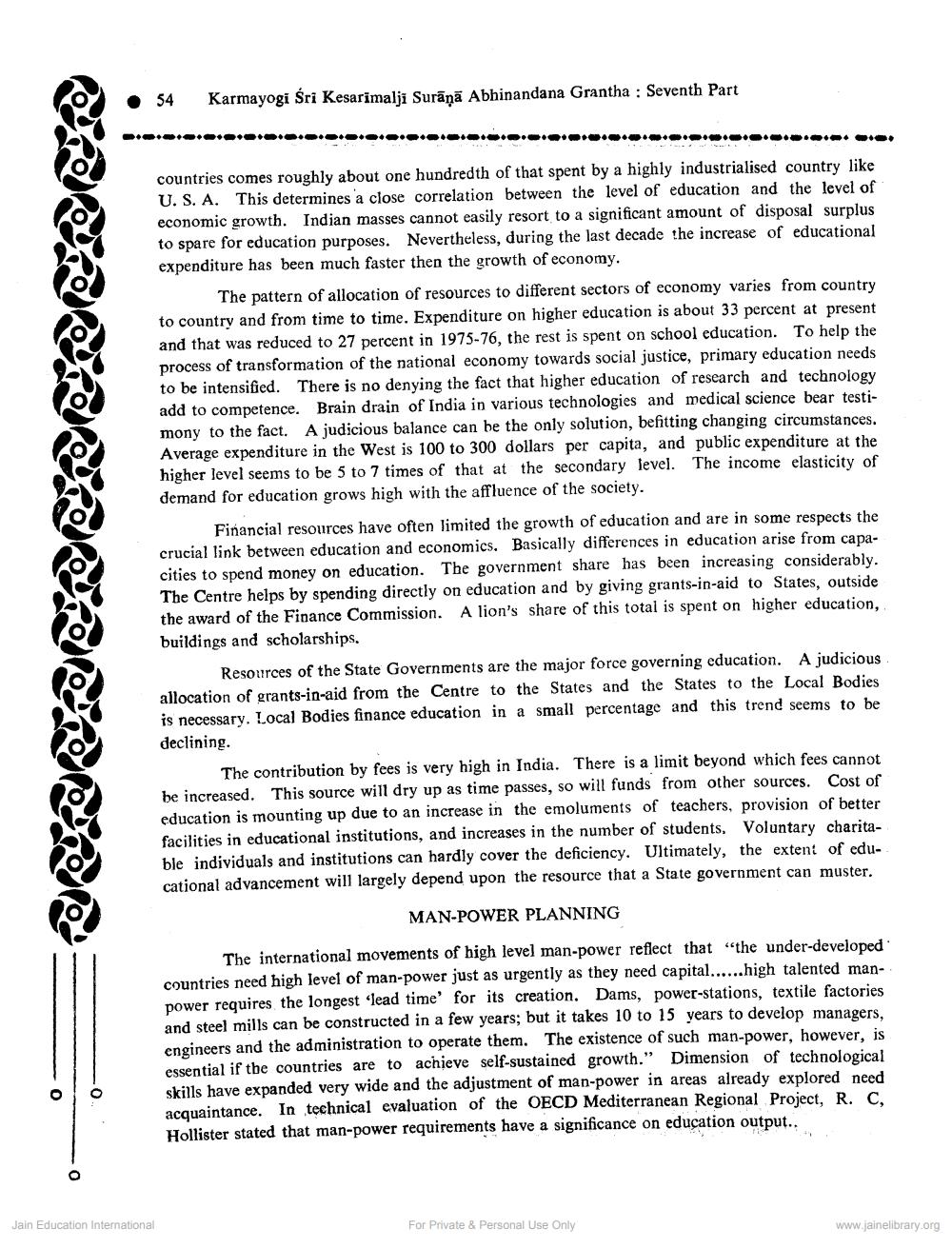Book Title: Education in economic perspective Author(s): B L Dhakad Publisher: Z_Kesarimalji_Surana_Abhinandan_Granth_012044.pdf View full book textPage 6
________________ • 54 Karmayogi Śri Kesarimalji Surāņā Abhinandana Grantha : Seventh Part O.O.O.O.O.O.O.O.O.O.O.O.O.O.O.O.O.O.O.OOO..OOOO.O.O. countries comes roughly about one hundredth of that spent by a highly industrialised country like U.S. A. This determines a close correlation between the level of education and the level of economic growth. Indian masses cannot easily resort to a significant amount of disposal surplus to spare for education purposes. Nevertheless, during the last decade the increase of educational expenditure has been much faster then the growth of economy. The pattern of allocation of resources to different sectors of economy varies from country to country and from time to time. Expenditure on higher education is about 33 percent at present and that was reduced to 27 percent in 1975-76, the rest is spent on school education. To help the process of transformation of the national economy towards social justice, primary education needs to be intensified. There is no denying the fact that higher education of research and technology add to competence. Brain drain of India in various technologies and medical science bear testimony to the fact. A judicious balance can be the only solution, befitting changing circumstances. Average expenditure in the West is 100 to 300 dollars per capita, and public expenditure at the higher level seems to be 5 to 7 times of that at the secondary level. The income elasticity of demand for education grows high with the affluence of the society. Financial resources have often limited the growth of education and are in some respects the crucial link between education and economics. Basically differences in education arise from capacities to spend money on education. The government share has been increasing considerably. The Centre helps by spending directly on education and by giving grants-in-aid to States, outside the award of the Finance Commission. A lion's share of this total is spent on higher education, buildings and scholarships. Resources of the State Governments are the major force governing education. A judicious allocation of grants-in-aid from the Centre to the States and the States to the Local Bodies is necessary. Local Bodies finance education in a small percentage and this trend seems to be declining. The contribution by fees is very high in India. There is a limit beyond which fees cannot be increased. This source will dry up as time passes, so will funds from other sources. Cost of education is mounting up due to an increase in the emoluments of teachers, provision of better facilities in educational institutions, and increases in the number of students, Voluntary charitable individuals and institutions can hardly cover the deficiency. Ultimately, the extent of educational advancement will largely depend upon the resource that a State government can muster. MAN-POWER PLANNING The international movements of high level man-power reflect that “the under-developed countries need high level of man-power just as urgently as they need capital...... high talented manpower requires the longest "lead time' for its creation. Dams, power-stations, textile factories and steel mills can be constructed in a few years; but it takes 10 to 15 years to develop managers, engineers and the administration to operate them. The existence of such man-power, however, is essential if the countries are to achieve self-sustained growth." Dimension of technological skills have expanded very wide and the adjustment of man-power in areas already explored need acquaintance. In technical evaluation of the OECD Mediterranean Regional Project, R. C. Hollister stated that man-power requirements have a significance on education output.. o o . Jain Education International For Private & Personal Use Only www.jainelibrary.orgPage Navigation
1 ... 4 5 6 7 8
